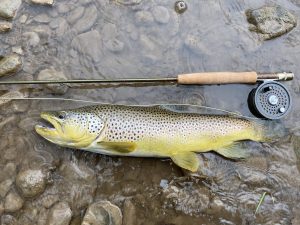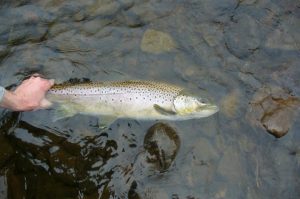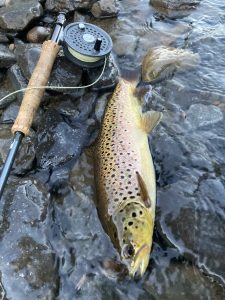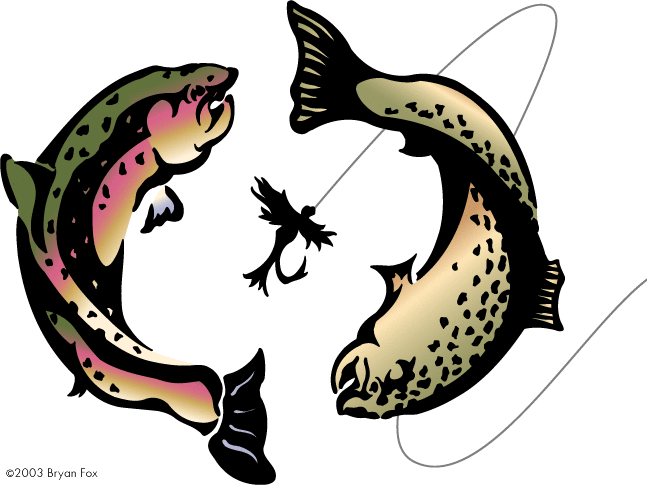Fly fishing for brook trout and then brown trout in the Catskills spawned the beginning of a whole new generation of fly fishers and fly fishing literature, which is now the basis of fly fishing lore in America.

History
The history of the brown trout in New York and the United States began in the late 1800s. Fred Mather, working for the U. S. Fish Commission, was sent to a fish cultural exposition in Berlin, Germany, there he met Friedrich Felix von Behr. Friedrich von Behr was a wealthy sportsman and the president of the German Fish Culturists Association. The two became friends and von Behr took Mather fishing to some streams in the German Black Forest, where Mather experienced fishing for a different species of trout, the brown trout. This relationship spawned the import of brown trout eggs to America and the first eggs arrived in the U. S. around February 1883. Some of the eggs went to the hatchery at Cold Spring Harbor, NY and some went to Caledonia, NY. Others were shipped to Michigan. These shipments contained both the lake form, Seeforelle, and the brook form, Bachforelle. Later shipments from Germany, Scotland, and England, were also used in streams in the U. S. and the fish quickly established self sustaining populations. One example is New York’s Beaverkill, where brown trout thrived and fish of up to eight pounds were recorded. The brown trout in the Beaverkill developed a reputation as a more wary and difficult fish to catch, which gave rise to a new fly fishing culture and thus was the beginning of a whole new generation of fly fishers and fly fishing literature, which is now the basis of fly fishing lore in America.

Brown trout are now stocked stocked throughout New York state. There are populations in both lakes and streams throughout the state and there is also abundant natural reproduction and there are also streams managed as wild brown trout fisheries.
Biology
In New York there are both stream resident and lake run brown trout. There is an immense variety of coloration among brown trout in New York. Brown trout can have both red and black spots. Some forms that spend much of their time in deep lakes may lack red spots and may take on a silvery appearance. Brown trout coloration and spot distribution also varies depending on diet and the stream or lake in which it lives.
Brown trout are fall spawners. Spawning is initiated when water temperatures drop below 50 degrees Fahrenheit and daylight shortens. The female brown trout will construct a spawning area called a “redd” in a shallow gravelly area by swimming on her side using her tail to clean the gravel. This may take a few days. This activity will attract attention from males. The males will then compete to determine who will fertilize the eggs. The number of eggs deposited depends on the size of the female. Successfully fertilized eggs will develop over winter and hatch in the spring. Brown trout living in lakes and feeding on fish can live up to 15 years. The typical steam brown trout will live for four years and grow to 15 to 20 inches.

The diet of the brown trout consists of aquatic invertebrates and insects as well as crustaceans and small fish and some terrestrial insects. In lakes the brown trout can grow very large, specimens of over 10 pounds are periodically caught in tributaries of Lake Ontario and the Finger Lakes.
Fly-fishing and Brown Trout

Fly fishing for brown trout is both challenging and enjoyable. Due to their selective nature when feeding and their very wary behavior, the pursuit of brown trout can require educated fly selection and careful and precise fly fishing techniques. The eyes of the brown trout are adapted to see in dim light, due to the abundance of rod cells in the retina. This can mean fishing can continue after dark and can be good on dark poor weather days. Brown trout can be taken on a variety of flies. During hatches of aquatic insects brown trout will often feed exclusively on a specific insect and will even feed on a specific stage of the insect which spawned the phrase “match the hatch,” where the angler must closely mimic the exact size, shape and sometimes color of the brown trout’s selected food. Lake run fish in the Finger Lakes will often hit a swinging streamer which mimics a small fish. This is also an exciting way to fish for brown trout in New York. Fishing with subsurface patterns such as stonefly, mayfly, caddis and midge imitations will also produce when fishing for lake run and stream resident forms, when insects are not emerging from the water. Fly-fishing for brown trout is both fun and challenging and the angler with persistence will be rewarded with a beautiful trout.
